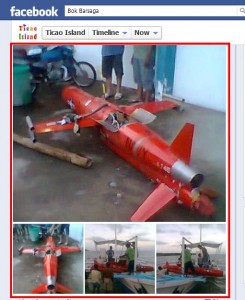
PAGADIAN CITY (Mindanao Examiner / Jan. 7, 2013) – Filipino fishermen have recovered a United States Navy aerial target drone at sea in Masbate province in the Bicol region.
Six photos of the red painted drone with markings NAVY surfaced on Facebook which showed the unmanned aircraft being loaded to a small fishing boat. Police said the drone appears unarmed.
The photos uploaded on the Facebook page of Ticao Island. It said: “Photo Courtesy of Mr. Bok Barsaga — at Tacdugan Beach Ticao Island, San Jacinto, Masbate, Philippines.”
The drone, called BQM-74e Chukar, is believed to have been produced by Northrop and commonly use in military exercises. It can be fired either from the air, on a ship or on land and remotely operated and can fly up to 40,000 feet.
It was not immediately known how the drone crashed in the sea since the last joint military exercises between the Philippines and the United States in Bicol region was in 2009.
And recent military war games between the two countries were held in the provinces of Zambales, Nueva Ecija, Tarlac, Cavite and Palawan in October last year.
According to various online reports, the drone is used primarily as a realistic aerial target, capable of simulating enemy threats for gunnery and missile training exercises.
The drone is capable of being recovered following a training exercise. A parachute is deployed by remote control or if the remote control link is severed and a flotation kit can be added for sea-based recovery.
If recovery of the drone is required, special telemetry warheads are used on the defensive missile in place of explosives. This telemetry warhead is desirable since it allows for extensive analysis of the performance of the defensive missile, including miss distance information that determines if a real warhead would have damaged the target.
A direct hit would likely destroy the drone. Gunnery systems would use non-explosive dummy munitions. Since gunnery systems are aimed in front of a moving target so it will fly through the blast-fragments, dummy munitions do not have to directly hit a target. Analysis of radar data would determine if the dummy munitions would have damaged the target drone. (Mindanao Examiner)

